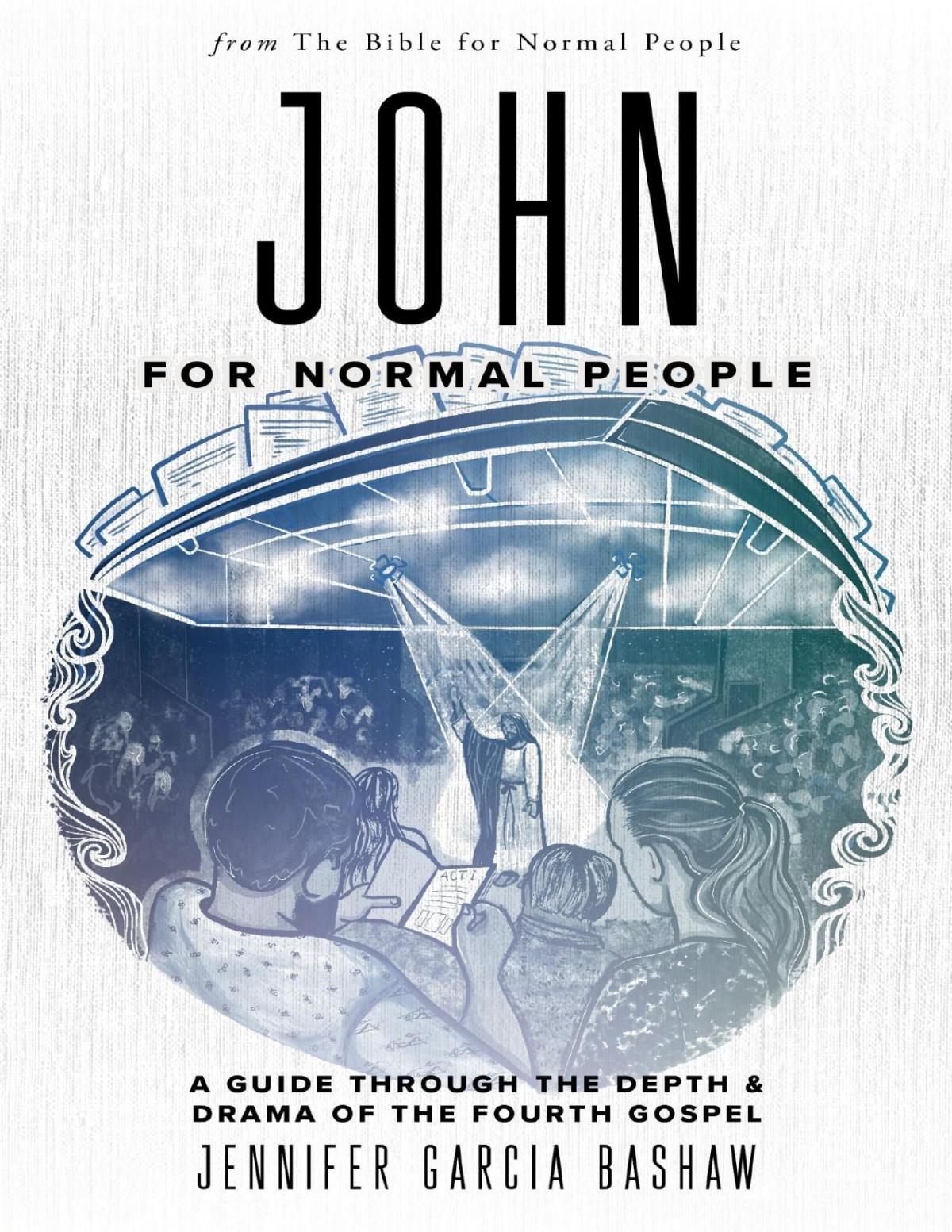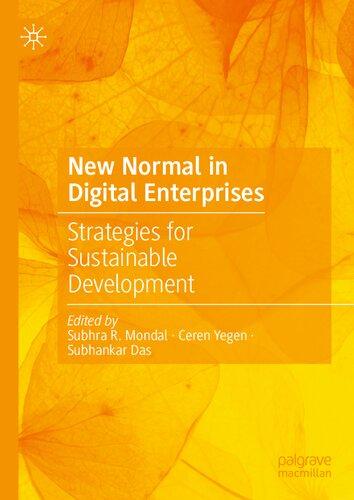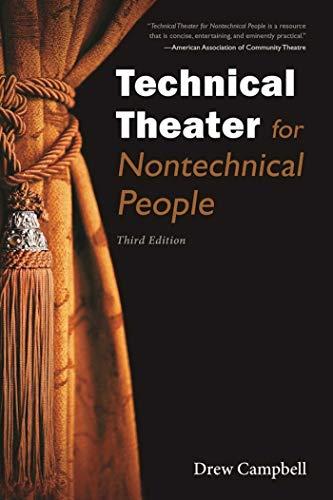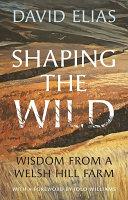Infomercial
Before you read John for Normal People, there are ten things you need to know (about me and the book):
1. Hi. I’m Jennifer (or Jen, if you like nicknames). I am going to be a passionate guide in this endeavor because I love teaching the Bible. I have always loved the Bible, albeit in di�erent ways throughout my journey. I remember sitting in church as a child and instead of listening to the sermon, I would read the stories in my pink Precious Moments Bible. I wrote little notes in the margins, sometimes asking questions, sometimes directing comments to God. I was curious and excited to learn more, understand more, and apply more of its messages to my life. My interest only grew as I got older. I was the Goody Two-shoes girl in youth group who looked forward to Bible studies and liked to talk theology (I didn’t know to call it that then) with my friends if they would indulge me. College only intensi�ed my obsession. I took quite a few Bible classes at my Baptist university, concurrent with a wide range of English lit classes and that’s when I began to study the Bible as literature. Over the course of my study, the naïve view of Scripture I inherited from my Southern Baptist background slowly burned away and I began to deconstruct and reconstruct my theology of the Bible. By the time I �nished my Master of Divinity degree, I knew I was going to teach the Bible, either as a minister or as a professor. I eventually chose the professor/PhD path because in my Texas, Southern Baptist context, it was easier for a woman to get a PhD and a teaching position than a senior pastorate. Don’t feel sorry for me, though. I love what I do for a living—teaching students and pastors about reading the Bible well, writing about biblical literature, and interpreting the complexity of Scripture for the public with �e Bible for Normal People. I humbly o�er all my study and my passion to you the readers of this commentary.
2. �e Gospels are my “ canon within the canon ” and I think they can provide the key to understanding the Bible. You may have heard the term “ canon within the canon ” before. It means that there is a section of the Bible that you prioritize over others, one that can become a lens through which you see the other parts of Scripture. Most people have a canon within the canon without acknowledging it, so it is better to be honest with yourself and accept that we all play favorites. (Paul’s letters tend to be the default canon within the canon for many evangelical traditions, for example, but few admit it). �e Gospels are 100% my canon within the canon, partly because their stories transcend time and speak to many generations and partly because they are our main source of knowledge about Jesus—a central way Christians understand the character of God and divine action in the world. As a Christ-centered Christian, I am committed to understanding the message of the Gospels about Jesus and using that knowledge to guide my interaction with the whole Bible, with God, and with human history. So, for me, the better I know the life and teaching of Jesus, the better I will comprehend everything else. �at is why I have studied the Gospels on an academic level for twenty-�ve years now. You might even say I have had an ongoing love a�air with the Gospels. �e Gospel of Mark was my �rst love, and I can recall the moment I fell head over heels for it. I was in a class with Dr. David Garland at George W. Truett Seminary and we were acting out the scene from Mark 5 when the shunned and bleeding woman sneaks up behind Jesus to touch the hem of his cloak. I was playing the part of the woman. I can ’ t describe to you exactly what it felt like to immerse myself in the story as a character, but it was perspective-altering. I almost cried when I reached out to touch the person who represented my source of healing. I knew then that I wanted to help other people experience the Gospel stories in the same way I did that day—as visceral, palpable, and transformational. I especially hope to do that with John, because…
3. John is just “built di�erent” than the other Gospels and encourages deep, experimental exploration. I tell my students that although Mark was my �rst love, John was the one I wanted to settle down with and marry. Yes, I
wrote my dissertation on Matthew (sort of by default) and I consider Luke to be my best friend but John is special. It does not tell the story of Jesus the way Matthew, Mark, and Luke do. �ere is an overwhelming fathomlessness to the Gospel of John that has always intrigued and stimulated me. Unfortunately, its depth cannot be accessed in the way we tend to read it today. In churches, the Gospel of John is read in bite-sized portions, often sucked dry of its original �avor and complexity. Our contemporary experience of John can be like chewing those tiny, dehydrated pineapple chunks in trail mix, but this Gospel was meant to be consumed like a sweet, fresh pineapple—in huge, ravenous bites with the juice running down our chins. I want to give you that juicy, John experience in this book. �at is why…
4. �is book is a theatrical, updated, and adapted presentation of the Gospel of John. You read that right. I have structured this commentary as a dramatic retelling of the story laid out in John. Instead of dividing the content into biblical chapters, I have separated it into acts (actually, a prologue, four acts, an intermission, and an epilogue). I still tell you what chapters in John we are covering and I stick to the order of John’s narrative (with one small exception), but my organization and narration is de�nitely theatrical. �is was done with great forethought to better communicate the impact of the text in its original context. Scholars have long recognized John was read aloud to its �rst audiences. It reads like an ancient drama, so I have approached the Gospel like a classic play—one that warrants a reimagined revival (how many versions of Hamlet have been adapted for screen or stage?). I took this task seriously, studying each passage and its messages to best communicate the original feel of the scene. Since I put so much work into reimagining the story of Jesus for the stage, I ask that you, the reader, keep in mind…
5. �is commentary is meant to be experienced, not just read for information. Let’s be honest—most commentaries are dry and matter-of-fact. People don’t usually sit down and read a commentary from cover to cover because that would be excruciatingly boring. �is, however, is not your average
commentary. I hope you will read it from cover to cover. My goal is to immerse you in the story of Jesus that John is telling, to connect you to the emotions and events narrated in the text, and to help you better understand how the �rst hearers of the Gospel of John would have experienced it. I will give you information, don’t worry about that. You’ll get explicit explanations of background issues and academic arguments, plus footnotes that expand on content and point you toward additional resources. But other information will be implicit—for example, the setup of a scene or the �ow of a chapter could demonstrate something about the original literary structure. �e music referenced may set the tone for a particular passage, orchestrating for a contemporary audience what the original audience would have implicitly understood. What I am saying is, pay attention not just to what I write but how I write it. Activate your imagination and picture yourself in a theater: feel the excitement in the air, hear the music coming from the pit, open yourself up to the experience of the Gospel. Which reminds me…
6. �ere are going to be theater staging descriptions and directorial asides in this dramatic commentary. I didn’t get fancy about it, but I did want you to be able to picture the staging and motion on stage as I describe it. So, here is a basic guide to stage directions:

7. Don’t be nervous, theater novices are welcome. Not only have I structured this commentary like a play, I have also included a good number of references to plays, especially musicals (which are my favorite). I drop some Broadway allusions here and there and draw examples from theatrical movies. I’ve even made a playlist for each act. (�is will enhance your experience of John for Normal People, so please listen to it!) You might be thinking, but I don’t like theater…is this book for me? Yes! You don’t have to love (or even like) the theater to gain a lot from this approach. I don’t particularly care for baseball, but I can appreciate Pete Enns’ baseball metaphors in his book, Curveball. Who knows? Maybe reading John like a play will awaken your inner thespian. But if not, you’ll still be better equipped to appreciate this highly dramatic Gospel when you experience it on its own theatrical terms.
8. We will cover historical background and social and cultural contexts, but our main focus will be on the text itself. Or, to use technical, scholarly
language, I will be using some historical-critical methodology in this commentary (my brilliant editors who lean more historical-critical than I do have made sure I included these), but the primary interpretive method I employ is narrative criticism. Narrative criticism focuses on reading biblical texts as literature, using tools from modern literary study as well as ancient literature and dramas. One of the main goals of narrative criticism is to determine what e�ect biblical stories are expected to have on their audience. �is is, in my opinion, the most productive way to study John because it is a complex and beautiful work of ancient literature.
9. A note about translation: you are going to have to trust me. I have gotten creative in the way I have written some of these scenes. Sure, sometimes I quote directly from the NRSVue, but sometimes I use my own translation and often that translation contains a little slang, or an updated idiom, or maybe a bit of paraphrase. Please know that every choice I have made is based on scholarship, my own study, and my desire to communicate the content of John in an accurate and relevant way.
10. �is commentary is going to frustrate you at some point. �e goal of this book is to help you know and experience the Gospel of John more deeply, not to give you a systematic theology of salvation or a complete picture of Jesus in the Gospels. I will talk about how John is di�erent from the other Gospels and I will highlight the theological statements made in John, but I am not going to indoctrinate you or invent answers to problems that aren ’ t addressed in the text. John does not package everything about Jesus into a pretty box with a bow and it does not tell us how its picture of Jesus is supposed to �t in with the Gospels of Matthew, Mark, and Luke. John is unapologetically contradictory to the other Gospels, its metaphors about Jesus are mired with mystery, and its apocalyptic outlook is downright disorienting. But it is also brilliantly descriptive, beautifully dramatic, and so rich in its theological language. I have tried to capture that unique and infuriating beauty in this commentary. So, if you �nd yourself wanting more as you read John for
Normal People, if you are frustrated or confused or longing for clearer answers, don’t blame me. Welcome to the Gospel of John.
CHAPTER
ONE
John from 30,000 Feet
You might have some questions as we embark on this journey through the Gospel of John:
What exactly is a gospel?
How historically accurate are the Gospels?
Why do we have four Gospels?
Where did John’s Gospel come from and why is it so di�erent from the other three?
What do we learn about Jesus from the Gospel of John?
Well, you are in luck because I am about to answer all of these questions in this introductory chapter (except for the last one because that is the subject of this entire book).
What Is a Gospel?
First things �rst: the four Gospels—Matthew, Mark, Luke, and John—are the main sources we have that tell us about the life and ministry of Jesus of Nazareth.1 �e genre (or literary type) of the Gospels is di�erent from any genre of writing we would recognize in modern literature. �ey ’ re actually di�erent from any ancient literature type too, because they comprise a mashup of di�erent genres. �e canonical Gospels display characteristics of ancient historiographies, novels, legends, and biographies. But if you did have to choose one, then the Gospels have the most in common with Greco-Roman “Lives” (bioi), a popular style of biography used by historians to memorialize famous leaders. Like these ancient historians, the Gospel writers chose key episodes from their subject’s life in order to convey the core of his or her
character. �ey sometimes organized Jesus’ words and actions thematically, rather than adhering to a strictly chronological timeline of his ministry. �eir narratives highlight Jesus’s death, rather than his childhood, because in antiquity, people believed how a person died revealed much about that person ’ s character. Most recently, scholars have also suggested that the Gospels especially the Gospel of John—favor a particular kind of Greco-Roman biography that made use of encomium, a speech that highly praises someone. Encomiastic biographies are like hype literature: their goal is to honor their subject, touting the person ’ s great character and accomplishments (like a eulogy would) and inspiring others to emulate them.
Since Jesus’s biographers intended to praise him and his work, it seems appropriate that we would call their writings Gospels, because the word gospel (euangelion) literally means “good news. ” Normally, when someone spoke of “good news ” in the Roman Empire it involved Rome’s political propaganda; it was used to paint a positive picture of Caesar’s eminence or the superiority of the Pax Romana. 2 When the Gospel writers use this term, they are emphatically NOT referring to Roman rule but are describing an alternative to the empire: the reign of God initiated by Jesus. �is kingdom was a di�erent kind of kingdom—it was good news for those living on the edges of society, not just Roman citizens who bene�ted from Caesar’s power. �e Gospel writers, then, were not merely reporting on Jesus’s life—they were retelling the good news about the kingdom Jesus was bringing and convincing their audiences that Jesus’s life and accomplishments were worth sharing. In this way, the Gospels might have included a bit of propaganda (not unlike the euangelion from which they take their name), but only in the best possible sense of the word.
How Historically Accurate Are the Gospels?
All this talk of genre raises an important question: how historically accurate are the Gospels if their main goal was to praise Jesus and hype up the new way of
life he taught? �e short (and aggravating) answer to that question is, we can ’ t know for sure. Ancient histories and biographies (even the non-encomiastic kind) valued persuasive description over the presentation of bare facts. It’s not that they weren ’ t concerned with truth; it’s just that the truths the Gospel writers were concerned with were the deep truths about who Jesus was, why he was important, and why people should follow him…and they did that e�ectively. �ey knew that inspiring speeches and well-crafted stories communicate these truths more successfully than accurate itineraries and lists of places and dates. We shouldn’t expect the Gospel writers to follow our modern standards of history and biography—they were ancient people, after all—but we shouldn’t assume that they were unreliable witnesses either. �ey made use of the best literary devices of their time to represent well the person who lay at the heart of their new reality. �at was a pretty important job, so you better believe that they took their responsibility seriously and that other early Jesus-followers held them accountable for what their stories taught.
Why Do We Have Four Gospels?
�is leads us to another introductory question—if each of the Gospels tell the good news about Jesus’s life and ministry, and use similar literary conventions to do so, then why do we need four di�erent Gospels? Wouldn’t one be enough? �ere are multiple reasons the New Testament has four Gospels—the diversity of traditions about Jesus, the unique perspectives each writer provides, and the historical circumstances of the Gospels are all factors. �e teachings of Jesus and about Jesus probably went through an oral period for about thirty years after Jesus’s death and resurrection. During this time, di�erent communities of Christians told and retold stories of Jesus. Traditions about him spread throughout the churches in the Roman Empire. Finally, when the evangelists began to weave the di�erent oral and written pieces of the Jesus story together, they used numerous snippets of these traditions and patterned these into their Gospels.
Each Gospel writer creates a distinct portrait of Jesus in their story-telling tapestry, emphasizing certain aspects of his character and highlighting what themes and motifs served their audiences best. �e writers did not sign their names to their Gospels (any names connected to the Gospels were added later), but we know from the Gospels’ content and from some early commentators on the Gospels that the authors did not write at the same time, from the same place, or to the same audiences. �ey were probably all written in the �rst century CE, but each had a di�erent provenance, or original background, and slightly di�erent purposes. �is is why we have four complementary but diverse stories about Jesus’s life, death, and resurrection.
While each Gospel has its own emphases, perspectives, and themes, they also have much in common with one another. Scholars who study the Gospels try to explain the connections between them by looking at their overlapping content and the sources they might have used. When comparing the Gospels, it is clear that Matthew, Mark, and Luke have the most content in common. �ey follow the same basic plot and timeline, with Matthew adding teaching content like the Sermon on the Mount to the content borrowed from Mark (which is likely the �rst Gospel written) and Luke expanding the focus and description of Jesus’s ministry. Because of the common content between these three Gospels, they are often called the Synoptic Gospels (syn + optic = seeing together). John, however, is in a league of its own.
Where Did John’s Gospel Come From and Why Is It So Di�erent from the Other �ree Gospels?
�e Gospel of John, sometimes called the Fourth Gospel because of its position in the Bible, has less content overlap with the Synoptic Gospels than one would expect—especially considering they all tell the story of the same man ’ s life. �e question of why John is so di�erent from the other Gospels is tied intimately to the questions of John’s authorship, date, and origin. So, before we talk about how and why John is di�erent, we need to address some
of the background information for John’s Gospel. A serious warning �rst: because the Gospel of John is an ancient document and because ancient people were less concerned with the kind of data we desire today, you will probably be disappointed with this next section. We don’t know with any degree of certainty who wrote John, when it was written, or who the original audience was. If you �nd a commentary online (or a blog or a social media post or a TikTok in�uencer) that o�ers con�dent answers to the background questions we have about John, I recommend you scroll on by. �at person has not done their homework, has a very mistaken view of ancient history, and/or has a controlling agenda. We simply do not have solid answers concerning the origins of the Gospels. But, since scholars have tried their best to o�er educated guesses over the years and have argued endlessly about the possibilities with regard to John’s provenance, I will o�er some of that interpretive conversation here. But don’t get your hopes up.
Let’s start with authorship. We have no clarity on whether John was written by one author at one time, multiple authors over stages of time, or a group of people, although all of these possibilities have been suggested. �ere is a literary reference that might provide a clue to the identity of the author in the book itself: a character called the “Beloved Disciple” (or the disciple whom Jesus loved) who shows up late in John’s narrative. �is disciple (often referred to by scholars as the BD) is leaning on Jesus’s breast during the Last Supper, remains with the women disciples at Jesus’s cruci�xion, and runs to the empty tomb with Peter. �e BD seems to be connected to the authority �gure behind the Gospel, and perhaps represents the source behind the stories and vocabulary in John that diverge from the stories and vocabulary we �nd in the Synoptic tradition. As the epilogue of John reports about the BD in 12:24, “�is is the disciple, the witness concerning these things, and the one who has written these things (or caused these things to be written–the verb there can mean either).” Church tradition dating all the way back to the second century CE has identi�ed the BD with John the son of Zebedee, one of the twelve apostles.3 Modern scholars, however, have suggested a wide array of
possibilities for the BD—Mary Magdalene, Lazarus, �omas Didymus—and some commentators see the character as a literary construct representing an idealized disciple or a group of disciples.4 One particular strand of interpreters from the 20th century proposed that the BD might represent a whole Johannine community, one that was sectarian in nature and had intentionally split from other forms of Judaism or Christianity in the �rst century.5
Realistically, we don’t know who the Beloved Disciple was nor do we know who the author was. But, let’s go ahead and move on to the dating of the Gospel and see if there is anything more helpful there. Scholars today mostly agree that John’s Gospel was written after the Synoptics, maybe several decades later, mostly because of the theological development apparent in its content (e.g., John presents a Jesus that is more comfortable talking about his connection to the divine, introducing a higher and more developed christology than we see in the Synoptics). Evidence within the text suggests a date after the destruction of the Jerusalem temple by the Romans (70 CE), mainly because the stories in John highlight synagogues over the temple and include several allusions to worship in places other than the temple. �e later end of the dating shouldn’t extend much past the 110s due to the fact that John is mentioned in several second-century sources.6 �is gives John a wide date range from about the 80s to the 110s CE.
When pressed, most contemporary scholars will place John sometime in the 90s CE, so we will assume that general dating here. Not to further complicate things, but it is also possible that John was written in stages by di�erent people or groups of people, with perhaps some chapters being written closer to the time of the Synoptic Gospels and others added decades later. If you sat down to read John from beginning to end, you would notice strange seams, and location and time hops that scholars call aporias, that suggest John underwent several stages of composition that were not smoothed out in the �nal editing process.7 �e 90s CE date, then, refers to the �nished Gospel, not the early stages of composition. If the Gospel had been �nished sometime in the 90s CE, then the �nal editors lived through a time period of persecution for
Christians, under either the emperor Domitian (who ruled 91–96 CE), Nerva (96–98 CE,) or Trajan (98–117 CE). �is period may also have been an era of separation between Christians, who started out as a sect within Judaism, and their Jewish parent faith (a process sometimes called the Parting of the Ways). In short, the Christians who wrote and edited the Gospel of John (as well as its �rst hearers and readers) would have been experiencing a time of political and religious tension. �e shaping and narration of Jesus’s life in the Gospel re�ects some of that tension and speaks into the late �rst-century context from which it comes (more on this below when I talk about Elvis).
�is brings us to another question that is nearly impossible to answer: where does John come from? Or, to be more exact, in which region of the Roman Empire might the Gospel of John have originated and who was its intended audience (to whom was it addressed and which community �rst received it)? �ese questions assume that the authors/editors were from the same geographical area and that they had a particular audience in mind when they composed the Gospel. �ese are relatively safe assumptions considering the nature of the Gospels, but the caveat is that we should be open to the idea that although the Gospels were written with speci�c audiences in mind, they were also intended for wider distribution to a more general audience. With that said, let’s narrow down the possibilities by looking at the context clues.
Because of the numerous allusions to Israel’s Scriptures and Jewish festivals within John, the Gospel’s audience likely includes ethnically Jewish Christians. �e harsh judgment levied against “the Jews” in John corroborates a Jewish origin—if it were composed for a predominantly Gentile audience, the language would not be as emotionally charged (we’ll come back to this intracommunal con�ict at the end of this chapter). However, if we place the �nal dating in the 90s CE, then there would likely have been a mix of Jewish and Gentile Christians in the audience. References to the Samaritans (John 4) and the “Hellenists” (7:35; 12:20) within the Gospel also point to a degree of ethnic diversity. �ese internal clues don’t really narrow down the possibilities for John’s origin much, but to humor people who like more concrete answers,
here are the top three scholarly answers concerning John’s origin (which are more like imaginative suggestions than answers).
Irenaeus, a second-century Bishop in France, locates the origin of the Gospel of John in the community of Christians gathered at Ephesus in Asia Minor. He asserts that John is written to combat a gnostic heresy popular in Ephesus. Since Western-educated scholars tend to love all things early church, and this is a SUPER early source, many of them cite Irenaeus as the gospel truth. However, we must factor in the potential bias of the writer; Irenaeus was, in his own second-century context, combating the gnostic heresy he attributes to John’s community. It is more likely that the heresy Irenaeus wrote against was a gnostic interpretation of John, rather than a belief that John knew of and refuted at the time the Gospel was written.8 �at doesn’t necessarily mean that the Ephesus connection is falsi�ed, but Irenaeus’s perceived intent does give some contemporary scholars pause. Outside of this reference, there is not much historical evidence placing the Gospel in an Ephesian context.
�e two other popular suggestions for John’s place of origin are Alexandria, Egypt (because the earliest manuscripts of John were found there) and Palestine itself (because the author seems geographically familiar with Judea and Galilee). �e hard truth that certainty-seekers need to face is that we don’t have enough evidence to locate the origin of John’s Gospel anywhere speci�c, and without new archaeological discoveries, we may never have that clarity.
Where we do have clarity regarding John is through what can be observed by reading it alongside the other Gospels. So, let’s move on to John’s divergence from the Synoptic Gospels. John follows a di�erent timeline and plot than the Synoptic Gospels and makes use of di�erent traditions (or stories) about the life of Jesus. While Matthew, Mark, and Luke present Jesus’s teaching in topically arranged parables and sermons, John utilizes private conversations (like those with Nicodemus and the woman at the well) or long speeches (like the Farewell Discourse) to do the same. While the Synoptics recount many of Jesus’s miracles, including a decent number of exorcisms, John narrates only seven or eight miracles (which he calls “signs”) and does not write about any
demon possessions. John lacks several key stories from the Synoptic Gospels, like Jesus’s temptation in the wilderness and the pleading prayer in the garden, but he adds a host of new material not seen in the other Gospels. John’s new material suggests either that the person (or community) behind this Gospel was unfamiliar with the Synoptic Gospels and used a separate strand of tradition (either written sources or oral) or that the author knew of the Synoptics (probably either Mark or Luke) in some form and deliberately chose to deviate from their stories and perspectives. Scholars have argued for any and every position possible on the spectrum of these two options. �e theory that is currently in vogue with prominent Johannine scholars is that John knew Mark’s Gospel and echoes some of its teachings and stories but chooses to tell the Jesus story in another way.9
You might be wondering, when compared to the Synoptics, how much value does John have for someone trying to reconstruct the historical life of Jesus? Scholars have given di�erent answers to this question throughout history. Many early Christians thought of John as a spiritual gospel, focusing on its perspective for understanding the theological signi�cance of Jesus.10 �e fourth-century Christian philosopher Augustine of Hippo summarizes the theological value of John like this: “John spoke about the Lord’s divinity in a way that no one else ever did.”11 Respect for the Fourth Gospel’s take on Jesus continued through the middle ages but John fell out of favor with commentators when biblical scholarship took a modern turn. �e “ quests for the historical Jesus,” which preoccupied scholars from the 19th century through to the late 20th century, dismissed the Gospel of John as a historical source for the life of Jesus, basing their reconstructions almost exclusively on the Synoptic Gospels.
We may not be able to assess the historical accuracy of John’s Gospel, but we do know that it was important to the early church and that the picture of Jesus that it presented was valuable and treasured. People throughout history have come to understand Jesus better, connect with God, and follow Jesus’s life example because of this book. We don’t have solid answers to the questions
modern people ask about John—“When was it written, by whom, and to whom?” or “How accurate are its stories concerning the historical Jesus?”—but what we do have is a well-crafted work of ancient literature written by people who cared to communicate truths about Jesus’s life and character.
And so that is how we are going to treat John. It is an ancient work of art and we are going to study it as such in this commentary. We are going to ask questions about what the Gospel is communicating and what we might learn from its teaching, but we are not going to pursue questions of historical accuracy. �at is like asking how many licks does it take to get to the center of a Tootsie Pop. �e world may never know. Since we cannot know what the historical Jesus did or said with any amount of certainty, our path forward involves appreciating the artistry of the Gospel and understanding its momentous claims about Jesus—the Word, who was with God in the beginning and was sent from God to make God known (John 1:1–18). �e message about Jesus in the Gospel of John re�ects the theology and experiences of some of the earliest Christians. Studying John will help us understand more about why a minority group facing the peril and persecution of the Roman Empire continued to follow and proclaim Jesus as their Messiah and source of life.
How Our Path Will Unfold
Before I lay out the approach of this commentary, it is important for me to share the foundational assumptions about the Gospel of John that undergird our study (note: I have based these assumptions on some of the best and most recent Johannine scholarship out there):
�e mysterious author(s) of John (referred to as “John” or “the authors” from here on) used creative methods to craft a compelling story about Jesus sometime in the late �rst-century Mediterranean world.
�e purpose of John is to illustrate Jesus’s identity and character and to provoke a positive response in its audience. �e end of John gives us the key to its purpose: “Now Jesus did many other signs in the presence of his disciples that are not written in this book, but these are written that you may believe (or continue to believe; the verb form here pisteuēte—supports either of these or both) that Jesus is the Messiah, the Son of God, and that through believing you may have life in his name (John 20:30–31).
�e Gospel of John has historical value, even if it does not present facts in the way we would like it to. It is a dramatic, historical witness to the impact that Jesus made in his context and to the developing traditions in the early church.
�e Gospel of John has a complex relationship to the Synoptic Gospels. Its distinctiveness from them provides a dissonant harmony for us that adds depth to our understanding of who Jesus was to the early Christians.
If you noticed a theatrical tenor to the descriptions I used above—John as a compelling story, as communicating to an audience, as a dramatic witness, as a dissonant harmony—congratulations! You have picked up on the theme of this commentary (or perhaps you just read the title and infomercial). Commentators on the Gospel of John have often compared it to dramas especially ancient Greek plays and the dramatic readings common in the Mediterranean world. John has a staged �air, with its characters constantly entering and exiting, its long soliloquies, and its cheeky narrator asides. It was written to be performed—read aloud to its audience—and it expected audience participation. So, while John could easily be placed on the library shelf next to Roman biographies, it would also be right at home next to the Greek plays.
John as a Creative Two-Level Drama
For a contemporary parallel, John shares characteristics with biopics and biographical plays and musicals. �e 2022 biopic Elvis chronicles the rise of one of the most iconic singers in American history. Although the �lm was based on biographical sources and portrays historical events, the main goal of director Baz Luhrmann was to capture the energy, character, and charisma of Elvis. �e �lm does this well in its retelling of Elvis’s rise to stardom, but it re�ects the sensibilities and concerns of the 2020s, when it was made, as much as it does the culture of the mid-1900s. Biopics tend to be two-level dramas, commenting on the issues of their present time even as they tell a story about a person from the past. John’s Gospel functions in this way. �e storyline is set in the 30s CE, during Jesus’s lifetime, but it is written half a century later, in the late �rst century. It is focused on portraying the character of Jesus in a way that also speaks to its current situation. As the authors narrate Jesus’s miraculous signs and counter-cultural teachings they address some of the concerns of their late �rst-century context. As I mentioned earlier, we don’t know the exact context of John’s audience, but we do see pieces of the narrative addressing issues the audience likely faced: questions about worship (since the temple had been destroyed), situations concerning the inclusion of Samaritans or Gentiles in a Jewish Christian community, and tensions between their community and their Jewish parent faith.
For example, in the story of the man Jesus healed from blindness (John 9), the Jewish leaders interrogate the man ’ s parents about the source of his healing. �e parents will not mention Jesus at all, “because they were afraid of the Jews, for the Jews had already agreed that anyone who confessed Jesus to be the Messiah would be put out of the synagogue ” (9:22). Scholars deny the possibility of such a thing—if Jesus’s followers were ever thrown out of synagogues, it would have occurred much later, when Christianity and Judaism began to split in the late �rst century. �is detail, then, speaks to the context of the Gospel audience, not to Jesus’s context. �e lines between past and present blur.
We can also see parallels to John’s Gospel in modern biographical plays and musicals, which employ creative methods of communication to bring a story to life. In the Tony award-winning musical, Hamilton, Lin-Manuel Miranda presents a brilliantly stylized account of the life of Alexander Hamilton. Miranda uses the mediums of hip-hop, R&B, pop, and soul music to narrate pieces of the Founding Father’s history. He also intentionally casts non-white actors to portray well-known white personalities from U.S. history. �e musical combines period costumes and historical details with modern lyrics and music styles in order to create its own story world. �e result is, in the words of Miranda, “a story about America then, told by America now. ”12 With his creative storytelling, Miranda connects his contemporary audience to the past, making the story of an immigrant who had a hand in crafting our country relevant to this moment in history. Miranda’s imaginative methods remind us of those we �nd in John’s Gospel. In John, the authors make use of a wide range of artistic devices including dualistic symbolism (light/darkness, life/death, belief/unbelief, etc.), poetry, speeches, dialogues, theatrical scenes, recurring “I am ” statements, allusions to Old Testament �gures and stories, and a repetitive structure centered on Jesus’s signs. We will deal with each of these as we come to them but, for now, know that all these dramatic tools serve to bring the ministry and message of Jesus to life for its audience, just like the hip-hop lyrics and updated casting did in Hamilton. John’s methods may not be ones we use or understand, but we will try our best to appreciate the �rstcentury context of the Gospel so that we might pick up on the brilliance of John’s story world.
�e structure of this commentary should help highlight John’s artistry and emphases. Because John’s goal is to characterize Jesus through his words, miraculous signs, and interactions with other characters, we are going to lean into the dramatic nature of the story. Each chapter will deal with discrete passages as interconnected scenes in a play. Jesus is the main character of almost every scene in John, so we will look at what each scene communicates about his identity and at how other characters in the scene enhance Jesus’s
characterization or teach us something about “the world.” I have arranged the scenes into acts and they are as follows:
THE PROLOGUE: JOHN 1:1–18
Overture & Origin Story
JESUS
�e Word | �e Light | �e Life | �e presence of God in the �esh tabernacling among us
SUPPORTING CHARACTERS
God, the Father | John (the Baptist) | �e World | �ose who accept the Word and those who reject the Word
ACT 1: JOHN 1–4
�e Messiah Makes His Debut
JESUS
�e Lamb of God | Rabbi | Son of Man | Son of God | King of Israel | Holy Spirit Baptizer | Messiah
SUPPORTING CHARACTERS
Jesus’s �rst disciples | Jesus’s mother | Religious leaders and crowds | Nicodemus | �e woman at the well | �e royal o�cial and his household
ACT
2: JOHN 5–8
Jesus: Love Him or Leave Him
JESUS
Son of the Father | �e Son of Man who will judge the world | �e prophet (who is to come into the world) | �e Bread of Life | �e Light of the World
SUPPORTING CHARACTERS
Religious leaders | �e man healed by the pool | Jesus’s family members | �e crowds | �e disciples who stay and the disciples who go
INTERMISSION & BONUS SCENE
ACT 3: JOHN 9–12
Light, Life, & the Pursuit of Salvation
JESUS
Son of Man | �e one who gives sight to the blind | �e Good Shepherd | �e Gate | �e Resurrection and Life | �e Way
SUPPORTING CHARACTERS
�e man healed from blindness | �e man ’ s parents | Mary, Martha, and Lazarus | �e divided crowds | Caiaphas and Jewish authorities | �e disciples
ACT 4: JOHN 13–20
Final Countdown
JESUS
�e Self-giving Servant | �e Glori�ed one | �e Spirit giver | �e Scapegoat
SUPPORTING CHARACTERS
Jesus’s mother and the other women | �e Beloved Disciple | Mary Magdalene | �omas | Peter and the other disciples
THE EPILOGUE: JOHN 21
A brief note about characters and perspective before we proceed: almost all of the characters in John are Jewish people in a �rst-century context. Some will be portrayed in a positive light by the authors and some will have negative titles and characteristics assigned to them. Scholars have not �gured out all the nuances of John’s portrayal of Jews. However, it is clear that there are negative feelings expressed about some of the Jewish characters in the story. We must be careful to view these characters and their literary descriptions as part of the story world, and not as legitimate assessments of the Jewish people or Judaism. Too many people throughout history have used the negative depictions of the character group called “the Jews” in the Gospel of John to discriminate against
















